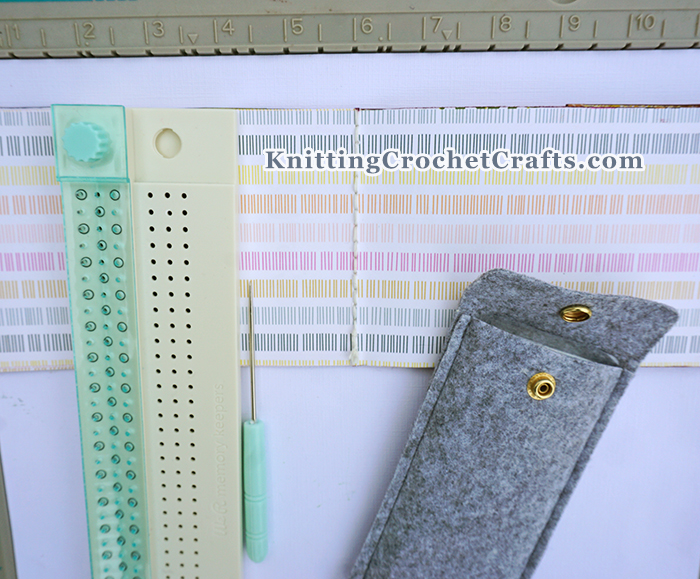
This is a product review of the Journal Book Binding Punch Guide by We R Makers / We R Memory Keepers (A Brand Under the American Crafts umbrella).
The Most Important Things You Need to Know About This Paper Crafting Tool:
The We R Makers Journal Book Binding Punch Guide empowers you to easily make your own mini albums, scrapbooks, journals, notebooks and other books featuring saddle stitch binding, Copic binding, or Japanese binding.
In addition to the book binding guide tool, the package also includes the following contents:
- An awl;
- A curved needle;
- A straight needle;
- Waxed thread for stitching book bindings;
- Instructions;
- And a storage pocket.
The entire package measures 13.6” x 4.125”.
The manufacturer’s numeric ID / MPN for this product is 660443.
Examples of Paper Craft Projects You Can Make With the Journal Book Binding Punch Guide by We R Makers / We R Memory Keepers:
Fall-Themed Mini Scrapbook Album
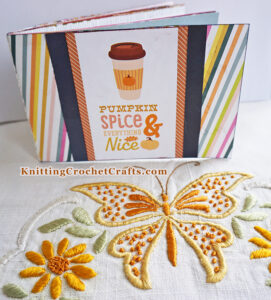
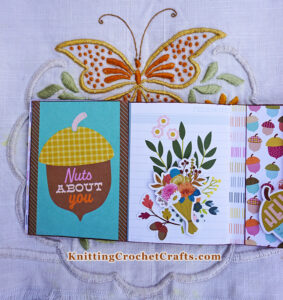
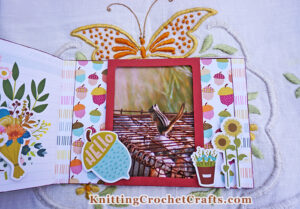
The Best Things About the Journal Book Binding Punch Guide by We R Makers / We R Memory Keepers
- Save Money: I bought the We R Makers Journal Book Binding Punch Guide because I’m working on making more than a decade’s worth of scrapbook albums, and I was spending a small fortune on page protectors and albums. I decided that it would be a better use of my funds to buy this tool, make my own albums out of paper, and skip buying the expensive page protectors and binders.
In my opinion, this tool’s primary benefit is that, in the long term, if you do a lot of scrapbooking, you will save money – probably thousands of dollars if you have a massive quantity of photos to document, and probably hundreds of dollars if you are more of a casual scrapbooker. If you’re a scrapbooker who doesn’t have hundreds or thousands of dollars to spend buying albums and page protectors, I recommend making the We R Makers Journal Book Binding Punch Guide a top priority purchase. If you use it consistently, it will pay for itself quickly. - Customize the Way Your Journals, Books and Albums Are Presented: This tool empowers you to easily create exactly the book or journal you need, which frees you from the limitations inherent in off-the-shelf store-bought albums. You can make your journal or album exactly the number of pages you need it to be. If you want to make your journals or albums with interesting shapes, you can do that – any shape you like (this is easiest if you have a die cutter and access to dies in the shapes you want). You can use virtually any cardstock or patterned scrapbooking paper to make your books. This means you are no longer limited to just using pre-packaged journals or albums that might or might not be available in the colors, sizes and patterns you need, and that might not have the ideal number of pages for the project you have in mind.
- Easy to Use: You do not need an engineering degree to use the We R Memory Keepers Journal Book Binding Punch Guide. If you have very basic hand sewing skills, the ability to measure, and the ability to poke holes in paper with a sharp tool, you pretty much have the skills needed to use the Journal Book Binding Punch Guide. If you don’t have those skills yet, no problem, because this stuff is pretty easy to pick up from watching videos and then just practicing. Instructions are provided. Furthermore, there are videos available online showing you step-by-step how to make mini albums and other projects with this tool, so you can watch those and get up and running with this tool easily.
- Save Time and Avoid Wasting Expensive Cardstock or Patterned Paper: It is possible to make your own books, mini albums, and journals without using the We R Makers Journal Book Binding Punch Guide; people have been doing so for centuries.
However, if you’re new to bookbinding, and you want to have a life outside of bookbinding, this tool will save you a lot of time and wasted paper. It’s a really handy shortcut that makes it possible to make professional-looking books without investing a lifetime into learning the ins and outs of the art of bookbinding. Personally, I’ve found that the books I’ve made without this tool tend to look amateurish, and the books I’ve made using this tool look much more impressive. - Save Massive Amounts of Space: If your goal is to make scrapbooks or scrapbook mini albums with this tool, you’re likely to find that the scrapbooks you make will be much thinner than store-bought photo albums that hold comparable numbers of photos. I live in a small space, so for me, this has been a huge, huge advantage. If you live in a sizable home, with plenty of storage space, this probably won’t be such an important issue for you.
Journal Book Binding Punch Guide Cons:
The Journal Book Binding Punch Guide isn’t for everyone. It has a few downsides. Here’s a list of what I think are the less-than-ideal things about it:
- You Have to Be Precise: This tool is really helpful, but it isn’t totally dummy-proof. Using it requires a significant amount of manual effort on your part. The books you make with this tool are only going to be as good as the effort you put into the book binding process. If you are distracted while lining up your pages for binding, or while punching the holes for sewing the binding, the odds are good that you’ll end up with a wonky book binding. You have to pay attention to what you’re doing when you use this tool. That said, in my opinion, it is far, far easier to use this tool than it is to do any of the above processes without the tool.
- Store-Bought Albums With Page Protectors Do a Better Job of Protecting Your Photos: If you’re a scrapbooker, and you’re contemplating a purchase of this tool so you can use it for making scrapbook albums or mini albums, there is one important consideration to ponder before you decide: How important is it to you to ensure that your photos will be protected?
If you’re scrapping with digital photos that can easily be reprinted, this isn’t such a big deal. But if you’re scrapping with old, irreplaceable vintage photos, or photos from a film camera where the original negatives have been lost, this is something I urge you to think about. I scrap enough digital photos that I found this tool to be a good value, but I’d really hesitate to recommend it to you if your primary goal is to make an album using vintage photos that were originally shot on film. In that case, I would steer you in the direction of using page protectors and albums like the Sn@p! Binders by Simple Stories, or something similar to those. They will provide a much greater level of protection for your photos than mini albums you could make with the We R Makers Journal Book Binding Punch Guide will provide. - You’ll Need to Come Up With an Album Storage Strategy: It is super easy to store store-bought scrapbook albums; most of them are designed to be lined up on bookshelves, and some of them even stand up on their own. In contrast, it isn’t so easy to figure out how to store the mini albums you’ll make using this Journal Book Binding Punch Guide. It isn’t at all easy to store them on bookshelves unless you create some sort of system for doing so. This is because, if you make your albums using simple paper covers, the covers are easily damaged, especially if you use lots of embellishments on the covers. If you stick your handmade mini albums between books on your shelves, you’re likely to find that they will get bent, torn and damaged quickly.
I solved this problem by storing my hand-bound mini albums in Artbin Super Satchels, which do a really fantastic job of protecting my hard work from damage. If you decide to buy yourself a Journal Book Binding Punch Guide, I recommend also considering the Super Satchel as a possible storage solution. It might or might not work for you, but either way, I do encourage you to think about how you will store the albums you make.

Conclusion
I enthusiastically recommend the Journal Book Binding Punch Guide to other crafters, particularly to crafters who are on a tight budget and have more time than money for making projects. This is also an ideal product for crafters who would rather spend time making exactly the book they want in the first place instead of trying to customize an off-the-shelf book purchase to make it into what they want. I’ve personally saved a small fortune using this tool; it has more than paid for itself.
Where to Buy the Journal Book Binding Punch Guide by We R Makers / We R Memory Keepers:
- Click or tap here to shop for this tool at A Cherry on Top Crafts (ACOT).
- Click or tap here to shop for this tool at Amazon.
Find More Excellent Paper Crafting Tools and Supplies
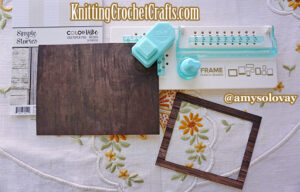
- We R Makers Frame Punch Board
- The Crop-a-Dile Disc Power Punch by We R Makers
- The Journal Guide by We R Makers
- More We R Makers Tools
- Best Craft Organizers in 2023
By Amy Solovay
About Your Product Reviewer: Amy Solovay is a content creator and educator who holds a bachelor’s degree with a studio art minor; she has also earned a separate degree in textile design. Amy learned to make collage art as a small child, and she still enjoys mixed media art techniques all these years later. Beyond that, she enjoys introducing other crafters to the best new craft supplies, and she also loves helping crafters learn new techniques for making the most of the craft supplies they buy.
As an educator, Amy Solovay used to teach in-person college courses in trend forecasting, marketing and surface design at California Design College in Los Angeles.
Nowadays, Amy uses online platforms to teach digital courses to craft pattern designers, content creators and influencers all over the world.
Thanks for visiting!
This page was last updated on 9-11-2024.